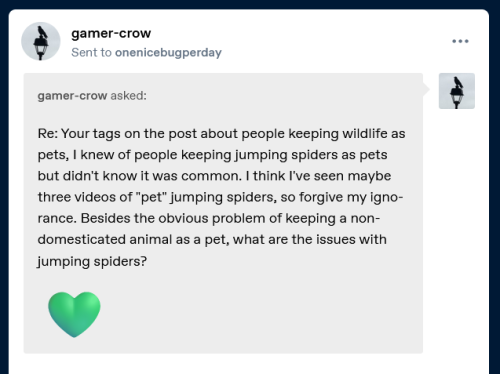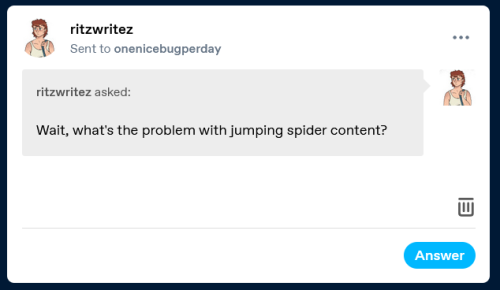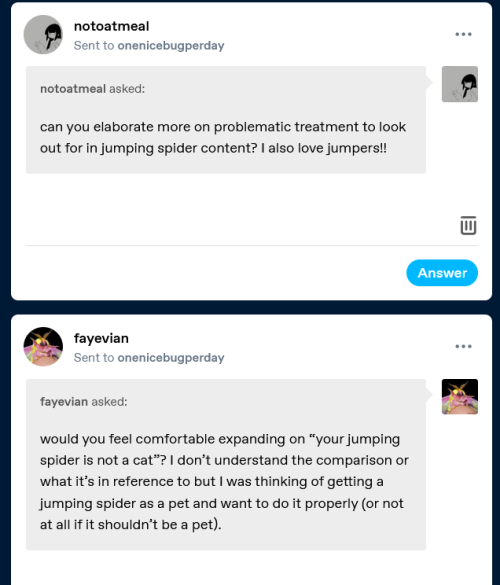Their Hair Makes Them Look So Round And Fat

their hair makes them look so round and fat
More Posts from Phoronopsis and Others
Even if a species of bug exhibits some kind of social touch among themselves (which I believe some are known to, though for the large majority of species I doubt there's any data on it), it's not going to be welcome from a towering colossus that they literally may not even be able to fit inside their whole field of vision. I feel like a lot of people forget just how big we are compared to most bugs
you know that one popular tumblr post that goes like "humans will pet anything" "well how wonderful that we live on a planet full of things that like to be petted!", or various other posts you see around the internet saying stuff like "humans evolved hands so we could pet all the animals 😌". sometimes I wonder how much those posts might have left actual lasting damage on public perception of animal behavior, like I'm sure they didn't intend to but like... did they
Well I certainly didn’t expect to illicit so many questions when I reblogged this post and added some tags about jumping spider content online.








Firstly, let me say there’s nothing wrong with keeping jumping spiders as pets. I have one myself. She’s a captive bred regal jumping spider. She’s currently a bit over two years old. I’ve had other jumping spiders as well, but they passed of old age and in one instance, a failed molt, which is fairly common.
Before and after getting pet jumpers, I joined some jumper groups, read a lot of care guides, and watched a slew of videos about keeping them.
It became obvious pretty quickly that apparently due to their cute fuzzy appearance, large round eyes, and intelligent behavior, people (owners, admirers, and popular content creators) assign human and mammal emotions and behaviors to them, often to their detriment.
I personally believe bugs are complex creatures that can be intelligent and have emotions, but that those emotions and behaviors are NOT analogous to human or mammal behavior and ignoring their natural needs and behaviors means you’re likely not providing proper care for them.
This is mainly about handling. Bugs don’t want to be handled. They get nothing positive out of it emotionally. They don’t want to be pet or cuddle with you. They don’t want to hang out with you. You’re a big scary predator, and it likely wants to get away from you. Forcing handling can stress, injure, or kill them. That’s why I tagged the post (linked above) “your spider is not a cat.” It doesn’t seek affection from you.
I can’t tell you how many posts or videos I saw where people were super upset because they let their jumper out of its enclosure to handle it and it either escaped and got lost or they somehow crushed it and killed or injured it badly. I’ve also seen people chasing their jumper around its enclosure trying to grab it or get it to jump onto their hand when it’s clearly just trying to hide.
As an example, a very common thing I’ve seen in videos about jumpers is people saying when they lift their front legs at you and jump or climb onto you/your hands it’s because they “want uppies” and want to be pet and be close to you. This is a wild misreading of behavior. Sometimes raising the front legs is a defensive display, trying to make itself look larger to scare away a threat. Other times, they’re waving their legs around to sense and feel their environment, or preparing to jump onto something. They are arboreal, and their natural behavior is to find a high vantage point, so climbing onto the big thing (you) nearby is normal. It’s not because it seeks your affection.
Certainly if you DO handle them frequently they can get used to it, and it becomes less stressful for them. But in my opinion the dangers outweigh any positives, and I don’t handle mine. These are wild animals that have not been domesticated, even when captive bred. If you want to give them enrichment, and you should, offer them prey to chase or interesting things to explore in a larger enclosure. For those that do still handle them, I’d encourage you to watch their behavior closely and read the spidery cues they’re giving you rather than assuming they’re feeling what a cute little mammal might be feeling in the same scenario.
I could go on with specifics about certain videos, but I wasn’t planning on writing a huge post and this is already long. Also I’m sure many people would disagree with me about some things I’ve said, and I’m not going to argue about anything. This is just how I feel based on what I’ve seen of online jumping spider content, and it’s why I no longer interact with most of it.
I saw this one paper where they made an artificial neural network based on the actual neural architecture of the fruit fly and trained it on pictures of flies to show that 1. individual fruit flies are visually distinct 2. they are probably able to differentiate between each other visually despite their vision being terrible. And as a comparison they had a bunch of experienced fly scientists (aka “flyentists”) try to identify the same pictures of flies and they failed miserably which I thought was really funny
This ability to re-identify flies across days opens experimental possibilities, especially considering that this performance was achieved with static images (16fps yields around a thousand estimates of ID per minute, allowing high confidence in the parsimonious correct identification). This is in contrast to the human ability to re-identify flies, which at low resolutions is barely better than chance.
Clearly, all models can learn to re-identify flies to some extent, underscoring the individual-level variation in D. melanogaster. Re-identifying flies is in fact easier for DCNs than CIFAR10 (at least with centred images of flies acquired at the same distance). Even the model that rivals, in some sense, the representational performance of humans does ten times better than humans. Why humans can’t tell one fly from another is not clear. Regardless of whether it was evolutionarily beneficial to discriminate individual flies, humans do have incredible pattern detection abilities. It may simply be a lack of experience (although we attempted to address this by only using experienced Drosophila researchers as volunteers) or a more cryptic pattern-recognition ‘blind-spot’ of humans. In either case, these findings should spur new experiments to further understand the mechanisms of human vision and experience and how they fail in this case.
these CRINGE scientists FAILED to identify flies that all our models could smho 🙄😤

@onenicebugperday found this cool lookin' bug at my local library the other day. I have no clue what it is, looks kinda like a bee or a wasp but a bit lankier, it looked like it was a bit less than 2 inches long, pretty big for bug standards. I love the white fluff around its neck!


important anomalocaris dorsal carapace representation... the anomalocarapace...

sick and tired of inaccurate anomalocaris paleoart ,, decided to take matters into my own hands




Jumping spider mimic planthoppers in the genus Rhotana
Photo 1 by tenebrionidfan, 2 by gancw1, 3 by budak, and 4 by deeqld
scientists: oh hey we found a new species of deep sea feather star, neat :)
the news: TERRIFYING and ALIEN creature with ONE THOUSAND ARMS discovered LURKING in the DEEP ABYSS of the sea
the public: omg im never swimming in the ocean again!!!
the animal:

-
 stardewkiddo liked this · 1 month ago
stardewkiddo liked this · 1 month ago -
 wolfteethe reblogged this · 2 months ago
wolfteethe reblogged this · 2 months ago -
 lavenderinkstains liked this · 2 months ago
lavenderinkstains liked this · 2 months ago -
 ant-dumbassery liked this · 2 months ago
ant-dumbassery liked this · 2 months ago -
 the-silly-creature reblogged this · 2 months ago
the-silly-creature reblogged this · 2 months ago -
 drwhornet reblogged this · 2 months ago
drwhornet reblogged this · 2 months ago -
 drwhornet liked this · 2 months ago
drwhornet liked this · 2 months ago -
 maybe-llewellyn liked this · 2 months ago
maybe-llewellyn liked this · 2 months ago -
 controlledarrhythmia liked this · 3 months ago
controlledarrhythmia liked this · 3 months ago -
 aconfusednorwhal reblogged this · 3 months ago
aconfusednorwhal reblogged this · 3 months ago -
 gubgivitis reblogged this · 3 months ago
gubgivitis reblogged this · 3 months ago -
 gubgivitis liked this · 3 months ago
gubgivitis liked this · 3 months ago -
 eggxeggxegg liked this · 3 months ago
eggxeggxegg liked this · 3 months ago -
 the-silly-creature reblogged this · 3 months ago
the-silly-creature reblogged this · 3 months ago -
 the-silly-creature liked this · 3 months ago
the-silly-creature liked this · 3 months ago -
 pantomime73 liked this · 3 months ago
pantomime73 liked this · 3 months ago -
 surelynotapornbot liked this · 3 months ago
surelynotapornbot liked this · 3 months ago -
 john-liberal reblogged this · 3 months ago
john-liberal reblogged this · 3 months ago -
 john-liberal liked this · 3 months ago
john-liberal liked this · 3 months ago -
 wretchelstyx liked this · 3 months ago
wretchelstyx liked this · 3 months ago -
 patheticmosasaur1 liked this · 3 months ago
patheticmosasaur1 liked this · 3 months ago -
 official-kaitlyn-yapping reblogged this · 3 months ago
official-kaitlyn-yapping reblogged this · 3 months ago -
 official-kaitlyn-yapping liked this · 3 months ago
official-kaitlyn-yapping liked this · 3 months ago -
 eldritchmoss liked this · 3 months ago
eldritchmoss liked this · 3 months ago -
 food-forever-friend reblogged this · 3 months ago
food-forever-friend reblogged this · 3 months ago -
 katacala liked this · 3 months ago
katacala liked this · 3 months ago -
 fullmooncellist liked this · 3 months ago
fullmooncellist liked this · 3 months ago -
 angrymoose reblogged this · 3 months ago
angrymoose reblogged this · 3 months ago -
 angrymoose liked this · 3 months ago
angrymoose liked this · 3 months ago -
 celerybeast reblogged this · 3 months ago
celerybeast reblogged this · 3 months ago -
 booradleysadly reblogged this · 3 months ago
booradleysadly reblogged this · 3 months ago -
 booradleysadly liked this · 3 months ago
booradleysadly liked this · 3 months ago -
 odahbliing liked this · 3 months ago
odahbliing liked this · 3 months ago -
 teloles-and-friends reblogged this · 3 months ago
teloles-and-friends reblogged this · 3 months ago -
 teloles-and-friends liked this · 3 months ago
teloles-and-friends liked this · 3 months ago -
 rotteneyejoe liked this · 3 months ago
rotteneyejoe liked this · 3 months ago -
 dinosaursock liked this · 3 months ago
dinosaursock liked this · 3 months ago -
 gallifreyanentomologist liked this · 3 months ago
gallifreyanentomologist liked this · 3 months ago -
 korvax404 reblogged this · 3 months ago
korvax404 reblogged this · 3 months ago -
 korvax404 liked this · 3 months ago
korvax404 liked this · 3 months ago -
 aroyalmint liked this · 3 months ago
aroyalmint liked this · 3 months ago -
 grigadf liked this · 3 months ago
grigadf liked this · 3 months ago -
 hellreek liked this · 3 months ago
hellreek liked this · 3 months ago -
 phoronopsis reblogged this · 3 months ago
phoronopsis reblogged this · 3 months ago









